MOBILE Proof of Coverage
Introduction
The Helium blockchain uses a novel work algorithm called "Proof-of-Coverage" ("PoC") to verify that Hotspots are located where they claim. Put another way, PoC tries to verify, on an ongoing basis, that Hotspots are honestly representing their location and the wireless network coverage they are creating from that location.
While current 5G Hotspots are also able to participate in the IoT Network and PoC, the CBRS Small Cell and 5G aspects of a 5G Hotspot require a new approach to validating PoC.
Modeled Coverage introduces a fundamental difference in using hexes for the Mobile Network compared to the IoT Network where hexes determine the locations and number of Hotspots within the given hex. In the Mobile Network, hexes determine where the coverage exists. Modeled Coverage data allows us to un-tie a Radio's location from its signal strength and propagation.
A CBRS Small Cell Radio ("Radio") can only operate as a transmitter; they cannot receive incoming data and thus can not "hear" one another directly.
LoRaWAN Hotspots utilize a PoC method that benefits from Hotspots being used as senders ("Beacon") and receivers ("Witness") of PoC activity; read more about Proof-of-Coverage
Proof of Coverage Milestones
Determining useful coverage and the impact on MOBILE PoC rewards will be based on a number of factors:

These factors will be rolled out in stages over the next twelve months and explained in detail to ensure Network Builders can take concrete steps to plan or improve their setups. Check out the MOBILE PoC Roadmap.
Reward Algorithm
The proposed new algorithm for MOBILE Reward calculation in the MOBILE Rewards Oracle is as follows:
- Supply the declared transmitter power of each Radio and its location to the Obstruction Data Oracle.
- Get all hexes that have coverage from Outdoor Radios based on the information from the Obstruction Data Oracle.
- Based on the location of Indoor Radios, get all hexes with Indoor coverage and all adjacent hexes.
- Use projected signal loss information from the Obstruction Data Oracle to determine the potential signal strength of each Outdoor Radio in each hex.
- For each hex, get at most 5 Outdoor Radios with the top signal strength of the same level.
- If there are more than 5 Radios with the same signal strength level, use the
coverage_claim_timevalue to determine the top 5 oldest installations wherecoverage_claim_timeis the timestamp when the Radio received the spectrum access grant for the first time. - To prevent rewarding "dead" Radios, we propose to reset
coverage_claim_timeif the Radio was not generating a Heartbeat for more than 72 hours and use the time of the last Heartbeat as the newcoverage_claim_time.
- Get max 5 Indoor Radios using the same approach as above for Outdoor Radios.
- Based on Modeled Coverage Reward Tiers, sum up all estimated
coverage points earned by each Radio in all hexes and multiply that by
speedtest_multiplierfor each Radio. - Divide the total number of MOBILE Rewards emitted during the Rewards Period by the sum of
multiples of
heartbeat_multiplier,estimated_reward_points, andspeedtest_multiplierfor each Radio to determine MOBILE Rewards perestimated_reward_pointfor Radio with a passing Speed Test and valid Heartbeats. - Multiply the MOBILE per
estimated_reward_pointby the sum of each Radio's reward points to determine the MOBILE Rewards for each Radio.
The new formula for Reward calculation per Radio:
| Variable | Description |
|---|---|
| Total rewards | |
| Heartbeat multiplier | |
| Speed test multiplier | |
| Estimated coverage points | |
| Epoch rewards per coverage point |
MOBILE token rewards
Calculation Example
For simplicity, assume that the total MOBILE Rewards per period is 10,000.
| Radio | Heartbeat | Heartbeat multiplier | Speed Test | Speed test Multiplier | Hex 1 - Hex 10 | Hex 11 - Hex 20 | Hex 21 - Hex 220 | Total Coverage Points | Total Reward Points |
|---|---|---|---|---|---|---|---|---|---|
| 1 (Outdoor) | Ok | 1 | Acceptable | 1 | 160 | 80 | 800 | 1,040 | 1,040 |
| 2 (Outdoor) | Ok | 1 | Poor | 0.25 | 80 | 40 | 120 | 30 | |
| Points | 1,070 |
Table 3. Simplified data for two Outdoor Radios with Heartbeat, Speed Test, and Estimated Coverage Points for one Reward Period.
| Radio | Heartbeat | Heartbeat multiplier | Speed Test | Speed test Multiplier | Hex 1 | Hex 2 | Hex 3 | Hex 4 | Total Coverage Points | Total Reward Points |
|---|---|---|---|---|---|---|---|---|---|---|
| 3 (Indoor) | Ok | 1 | Degraded | 0.5 | 100 | 100 | 100 | 400 | 700 | 350 |
| Points | 350 |
Table 4. Simplified data for one Indoor Radio with Heartbeat, Speed Test, and Estimated Coverage Points for one Reward Period.
Where R is the reward per one estimated coverage point.
| Calculation | Total MOBILE Rewards | |
|---|---|---|
| Radio 1 (Outdoor) | 6.54 x 1 x 1 x 1040 | 6,806.30 |
| Radio 2 (Outdoor) | 6.54 x 1 x 0.25 x 120 | 903.14 |
| Radio 3 (Indoor) | 6.54 x 1 x 0.5 x 700 | 2,290.58 |
Modeled Coverage
With the passing of HIP-74 Modeled Coverage aims to allow for more appropriate Rewards and incentivizes the deployment of Radios at optimal locations.
This new algorithm uses the location of the Radio to calculate MOBILE Rewards based on the number of res12 hexes receiving coverage from a given Radio.
The MOBILE Rewards Oracle will calculate a coverage model for each Radio by considering the physical location, antenna direction, radio max transmit power to calculate the number of res12 hexes receiving coverage from each Radio.
Depending on the number of res12 hexes and the resulting signal power in each, the MOBILE Rewards Oracle will allot Coverage Points to a given Radio for calculating its MOBILE Rewards instead of assuming a fixed Radio Type multiplier Reward.
Reward Hexagon Sizing
Analysis of the coverage by a single Outdoor Radio with Modeled Coverage data shows that the res8 hex used in the IoT Network is too large to represent a Radio's coverage. Using res12 hexes better aligns with what an Outdoor Radio can reasonably cover, with an average area of 0.0003071 km² and an edge length of 9.4 m, slightly bigger than an average single-family home.
To summarize:
- Hexes in the Mobile Network identify the level of coverage from all the different Radios providing coverage to each res12 hex.
- A Radio can provide coverage for a hex it is not located within.
- A Radio can earn Rewards by providing coverage in multiple hexes.
To help visualize the significant difference between these two resolutions, below is a map with a green res8 hex and a purple res12 hex inside.
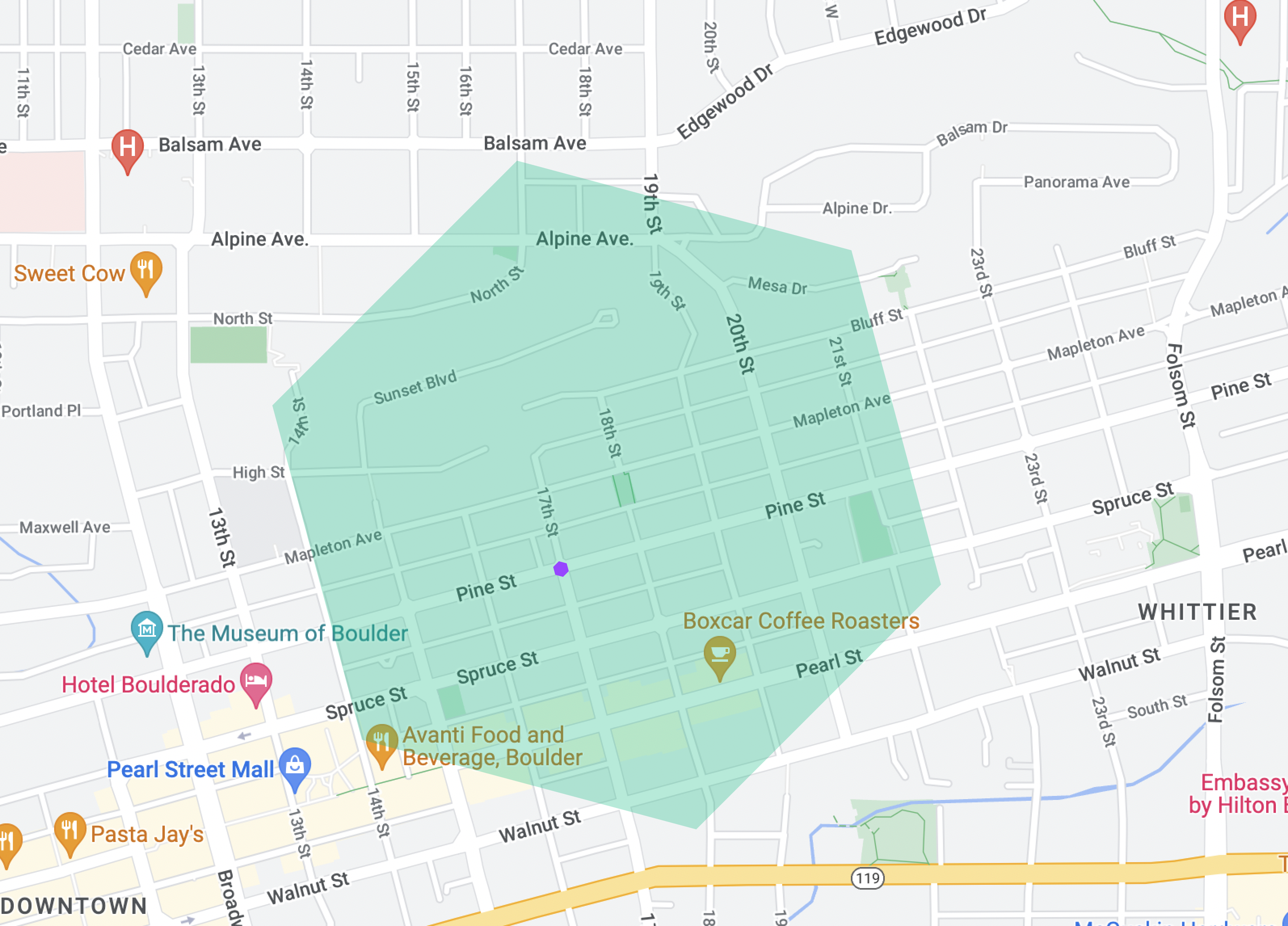
Modeled Coverage Reward Tiers
Each Radio is given a coverage points value depending on the number and signal strength of the res12 hexes receiving coverage from the Radio.
Outdoor Radios
Modeled Coverage replaces Radio Type multipliers with coverage points represented by four tiers
of potential signal power as modeled by the Obstruction Data Oracle - High, Medium, Low, and
None.
The reward tiers for Outdoor Radios will be as follows:
| Tier 1 | Tier 2 | Tier 3 | Tier 4 | |
|---|---|---|---|---|
| Potential Signal Power | ||||
| Potential Signal Level | High | Medium | Low | None |
| Estimated coverage points | 16 | 8 | 4 | 0 |
The Modeled Coverage algorithm limits the radius of coverage for a given Radio to 1000 meters. This value results from evaluating a selection of "ideal case" Radios, which provided usable coverage to roughly 500 meters and doubled that value. A larger radius would also be too heavy for the computation and is a current trade-off.
Indoor Radios
Like Outdoor, Indoor Radios can collect MOBILE Rewards by providing coverage in multiple hexes.
The Obstruction Data Oracle cannot evaluate coverage by Indoor Radios as there are no good and reliable data sources about obstacles in indoor spaces. Instead, the Modeled Coverage Oracle uses an approximation based on the data gathered while testing certified Indoor Radios in various indoor settings.
From this testing, the hex in which an Indoor Radio is physically located receives maximum signal strength coverage, and all adjacent hexes receive lower signal strength. Therefore, the algorithm errs on generosity to ensure equitable potential MOBILE Rewards for Indoor Radio coverage.
Estimated per-hex coverage points for Indoor Radios are intentionally significantly higher than those awarded to Outdoor Radios to balance the importance of Indoor Radios in the Mobile Network with their relatively smaller coverage footprints.
The reward tiers for Indoor Radios will be as follows:
| Tier 1 | Tier 2 | |
|---|---|---|
| Location | Inside hex | All adjacent hexes |
| Potential Signal Level | High | Low |
| Estimated coverage points | 400 | 100 |
These values were chosen by taking all the Outdoor Radios in an example area and analyzing the resulting distribution of estimated coverage points per Radio. Estimated coverage point values were chosen such that Indoor Radios receive roughly ¼th the estimated coverage points as the 95th percentile Outdoor Radios and about ½ the points of the average Outdoor Radio.
These results align with the current Radio Type Multipliers approach 1:2.5:4 for Indoor Radios,
Outdoor Radios, and High-Power Outdoor Radios. Figure 2 below is the cumulative distribution
function plot of the sample market Outdoor Radio estimated coverage points.
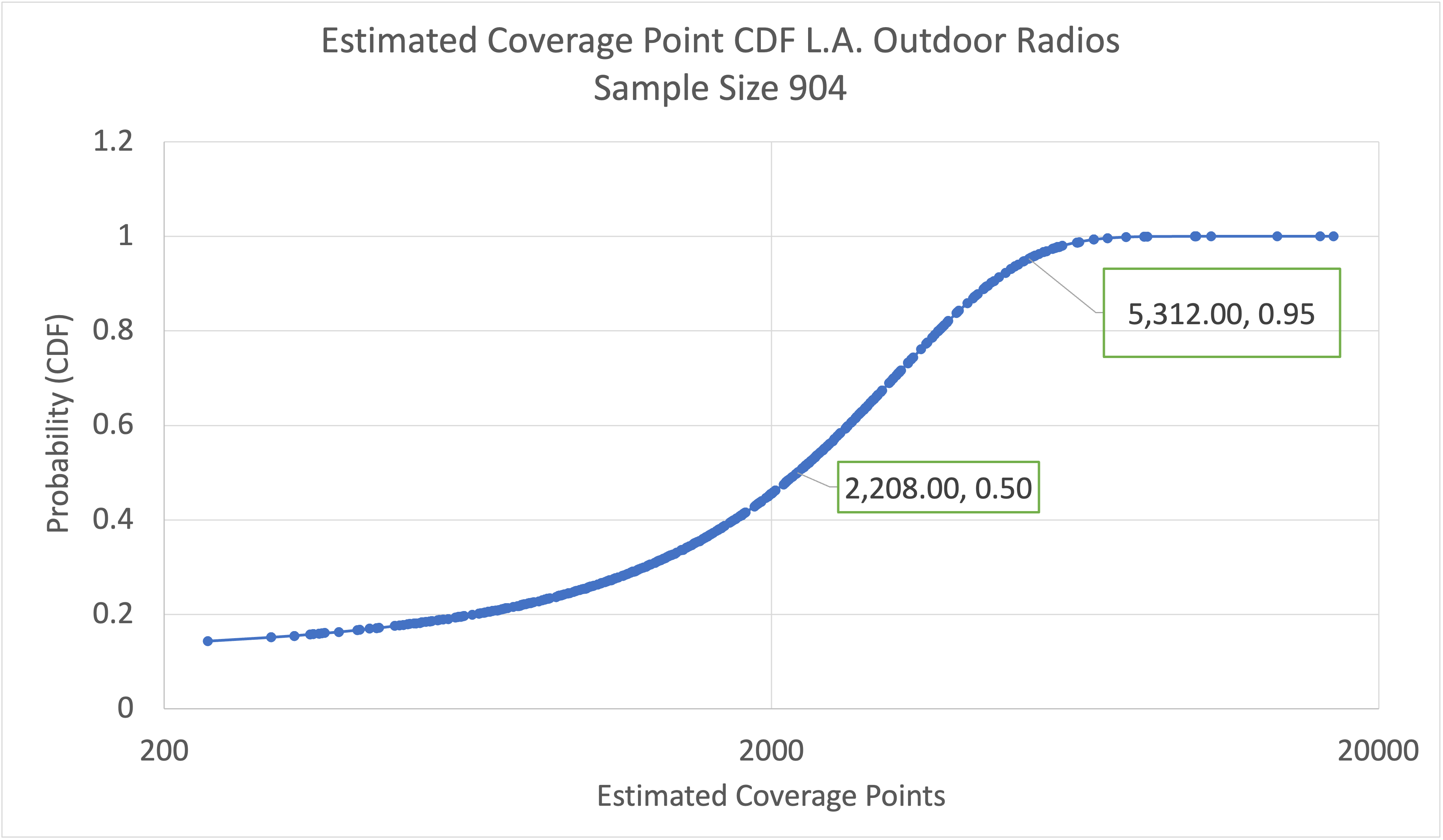
Cumulative distribution function of Outdoor Radio estimated coverage points for 904 Radios in the L.A. market area.
Modeled Coverage Explorer
View mobile Hotspot coverage on the Modeled Coverage Explorer.
Modeled Coverage data will play a key role in providing information to visualize it, with more data added as additional external sources come into play.
HIP-74 proposed the creation of a new Mobile Explorer dedicated exclusively to the Mobile Network as adding more features and data for MOBILE Rewards to the IoT Network Explorer becomes practically impossible as the Mobile Network grows. The first iteration of the Mobile Explorer proposes a basic map overlay of 5G data coverage with signal strength.
Uptime Heartbeats
A "heartbeat" is data sent by the 5G Hotspot indicating that a connected Radio is authorized to transmit 5G coverage.
Heartbeats occur every 60 seconds and transmit authorizations are valid for 240 seconds. This rolling overlap ensures that a Small Cell Radio can broadcast on an ongoing basis while allowing for brief interruptions.
To encourage reliable signal availability, 5G Hotspots and connected CBRS Small Cell Radios must generate at least one valid heartbeat per hour in 12 unique hours of the 24-hour Reward Period.
Heartbeat Reward Tiers
Each Radio is given a heartbeat multiplier of either 0 or 1.
Each Radio is awarded 1 point for a valid heartbeat in each hour, with a maximum of 24 points in the
Reward Period. All Radios with at least 12 points in the 24-hour Reward Period are given a
heartbeat multiplier of 1 and will be eligible to earn MOBILE Rewards.
Heartbeat Examples
Choose from the options below to see some heartbeat example scenarios and the impact on MOBILE rewards.
- ✅ No Missed Heartbeats
- ✅ Half Day Offline
- ⛔️ Mostly Offline
The Radio generated a heartbeat every hour of the day, earning 24 points.
This Radio will be eligible for rewards during the Reward Period.
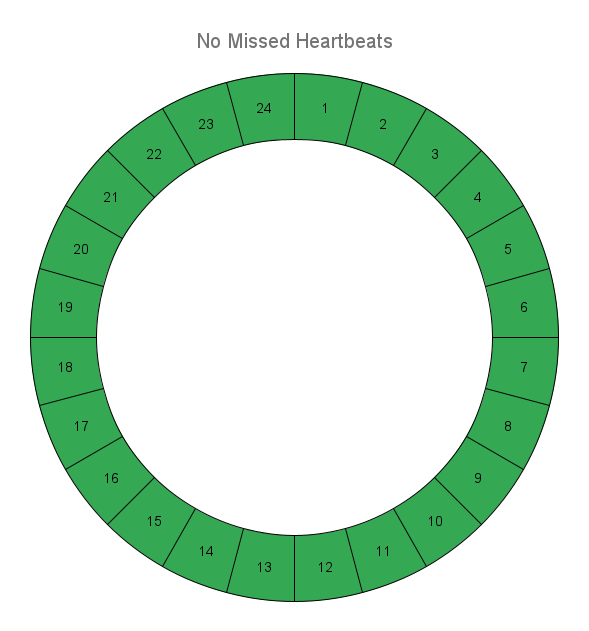
The Radio did not generate Heartbeats for 12 hours, earning 12 points.
This Radio will be eligible for rewards during the Reward Period.
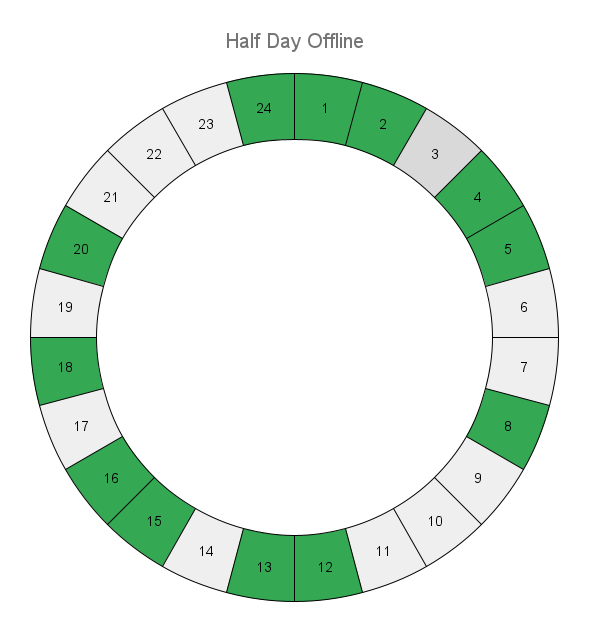
The Radio did not generate Heartbeats for 19 hours, earning 5 points.
This Radio will not be eligible for rewards during the Reward Period.
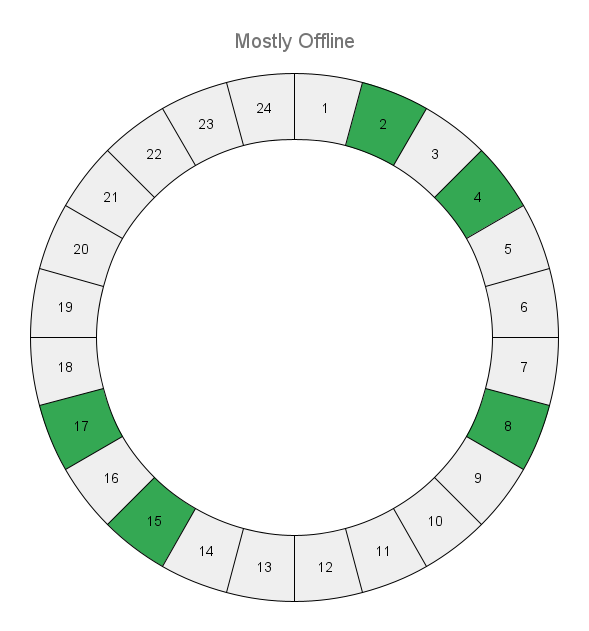
Backhaul Speed Tests
A 5G Hotspot automatically performs Speed Tests, with the results averaged by the MOBILE PoC Oracle. The MOBILE PoC Oracle includes these Speed Test metrics in the Rewards calculations for each 5G Hotspot.
The 5G Hotspot will randomly measure download, upload, and latency to the MOBILE verifier twice in a given 24-hour period. If a test can not complete successfully, the 5G Hotspot automatically retries every 30 minutes until a Speed Test is successful. The first Speed Test for a newly installed 5G Hotspot is performed within the first 12 hours after powering it on.
A minimum of two and maximum of six Speed Tests are required in the previous 48 hours to calculate a Moving average results for each download, upload, and latency, after which a new series of Speed Test results must be collected before a Moving Average can be calculated.
Speed Test Reward Tiers
Each 5G Hotspot is given a speedtest multiplier of either 0.0, 0.25, 0.5, 0.75 or 1.0.
This multiplier is applied to all connected Radios in rewards calculations.
Many locations where CBRS connectivity is being deployed, including some rural areas, do not always have the high-speed Internet connectivity needed to meet the acceptable Internet requirements for Genesis rewards consistently.
Often these areas do not have good cellular coverage either. That's why we believe it is essential to incentivize Helium deployments in less well-connected areas.
In response to community feedback and further exploration by Chris from DeWiPulse for his
analysis of and commentary on public Internet data in the United States,
Speed Test results are categorized into one of four Tiers - Acceptable, Degraded, Poor, and
Fail.
| Speed Test Tier | Speedtest Multiplier | Requirement (speeds in Mbps, latency in ms) |
|---|---|---|
| Good | 1.00x | 100+ Download, AND 10+ Upload, AND <50 Latency |
| Acceptable | 0.75x | 75+ Download, AND 8+ Upload, AND <60 Latency |
| Degraded | 0.50x | 50+ Download, AND 5+ Upload, AND <75 Latency |
| Poor | 0.25x | 30+ Download, AND 2+ Upload, AND <100 Latency |
| Fail | 0.00x | <30 Download, OR <2 Upload, OR >100 Latency |
Tiered Speed Test values are used as a multiplier in Rewards calculations as follows:
- Speed Test Results are put into Tiers based on the minimum value of each Download, Upload, and
Latency (logical
AND). - Speed Test results that do not meet the minimum requirements for any Download, Upload, or Latency
are considered to have
Failedand are not eligible for Rewards until the Speed Test Average is improved (logicalOR).
As the needs and realities of the Network change, backhaul requirements will evolve to better suit the Network and its users.
Speed Test Examples
Choose from the options below to see some speed test example scenarios and the impact on MOBILE rewards.
- ✅ All Acceptable
- ❎ Degraded Upload
- ⛔️ Poor Download
- 🆘 Failed Latency
Download 200 -> `Good`
Upload 40 -> `Good`
Latency 15 -> `Good`
---------------------------------
Speed Test Tier -> `Good` -> 1.0x Multiplier
Download 200 -> `Good`
Upload 6 -> `Degraded`
Latency 15 -> `Good`
---------------------------------
Speed Test Tier -> `Degraded` -> 0.5x Multiplier
Download 40 -> `Poor`
Upload 6 -> `Degraded`
Latency 15 -> `Good`
---------------------------------
Speed Test Tier -> `Poor` -> 0.25x Multiplier
Download 200 -> `Good`
Upload 40 -> `Good`
Latency 150 -> `Fail`
---------------------------------
Speed Test Tier -> `Fail` -> 0.0x Multiplier
Speed Test Example Calculations
Here are a set of tables to help visualize the components that make up the Speed Test result.
It may take up to 12 hours for newly connected 5G Hotspots to perform a Speed Test, and a minimum of 2 Speed Tests are required for the MOBILE PoC Oracle to calculate a moving average.
- ✅ Successful Speed Test
- ✅ Failing A Speed Test
- ❎ Missing A Single Speed Test
- ❎ Multiple Sub-Optimal Speed Tests
- 🆘 Missing Multiple Speed Tests
This 5G Hotspot is passing all Speed Test metrics and is providing a high-quality connection.

Test 1
This 5G Hotspot will not be eligible for rewards during the Reward Periods for which the results of Test 1 are the most recent as there is not enough data to calculate a Moving Average.
Test 2 and Later
This 5G Hotspot will be eligible for full rewards during the Reward Periods for which the results of these are the most recent.
This 5G Hotspot has failed its Speed Test on all metrics in Test 6, but the Moving Average stays within the passing range.

Test 1
This 5G Hotspot will not be eligible for rewards during the Reward Periods for which the results of Test 1 are the most recent as there is not enough data to calculate a Moving Average.
Test 2 and Later
This 5G Hotspot will be eligible for full rewards during the Reward Periods for which the results of Tests 2 and later are the most recent.
This 5G Hotspot has not reported Speed Test data at Test 5.

Test 1
This 5G Hotspot will not be eligible for rewards during the Reward Periods for which the results of Test 1 are the most recent as there is not enough data to calculate a Moving Average.
Test 2 through 4
This 5G Hotspot will be eligible for full rewards during the Reward Periods for which the results of Tests 2 through 4 are the most recent.
Test 5 through 6
This 5G Hotspot will not be eligible for rewards during the Reward Periods for which the results of Tests 5 through 6 are the most recent as there is not enough data to calculate a Moving Average.
Test 7 and Later
This 5G Hotspot will be eligible for full rewards during the Reward Periods for which the results of Tests 7 and later are the most recent.
This 5G Hotspot has less than Acceptable Speed Tests in Tests 3, 4, 5, and 6. This has caused the
Moving Average to fall for Tests 6, 7, and 8.

Test 1
This 5G Hotspot will not be eligible for rewards during the Reward Periods for which the results of Test 1 are the most recent as there is not enough data to calculate a Moving Average.
Test 2 through 5
This 5G Hotspot will be eligible for full rewards during the Reward Periods for which the results of Tests 2 through 5 are the most recent.
Test 6 through 8
This 5G Hotspot will be eligible for half rewards during the Reward Periods for which the results of Tests 6 through 8 are the most recent as at least one Speed Test metric Moving Average has not met or exceeded the required values.
Test 9 and Later
This 5G Hotspot will be eligible for full rewards during the Reward Periods for which the results of Tests 9 and later are the most recent.
This 5G Hotspot has not reported Speed Test data during Test 5, 6, or 7. This is often a result of a 5G Hotspot being disconnected from the Internet for a long time.

Test 1
This 5G Hotspot will not be eligible for rewards during the Reward Periods for which the results of Test 1 are the most recent as there is not enough data to calculate a Moving Average.
Test 2 through 4
This 5G Hotspot will be eligible for full rewards during the Reward Periods for which the results of Tests 2 through 4 are the most recent.
Test 5 through 8
This 5G Hotspot will not be eligible for rewards during the Reward Periods for which the results of Tests 5 through 8 are the most recent as there is not enough data to calculate a Moving Average.
Test 9 and Later
This 5G Hotspot will be eligible for full rewards during the Reward Periods for which the results of Tests 9 and later are the most recent.
Statistics on Helium Explorer
Speed Test metrics are viewable on the 5G Hotspot's page on Explorer under the 5G Statistics tab.
Here are examples of each status and a brief description of each metric and the resulting impact on
Rewards calculations.
Helium Explorer Examples
Choose from the options below to see some example scenarios and the impact on MOBILE rewards.
- ✅ Speed Test Passing
- ❎ Degraded Latency
- ❎ Poor Download
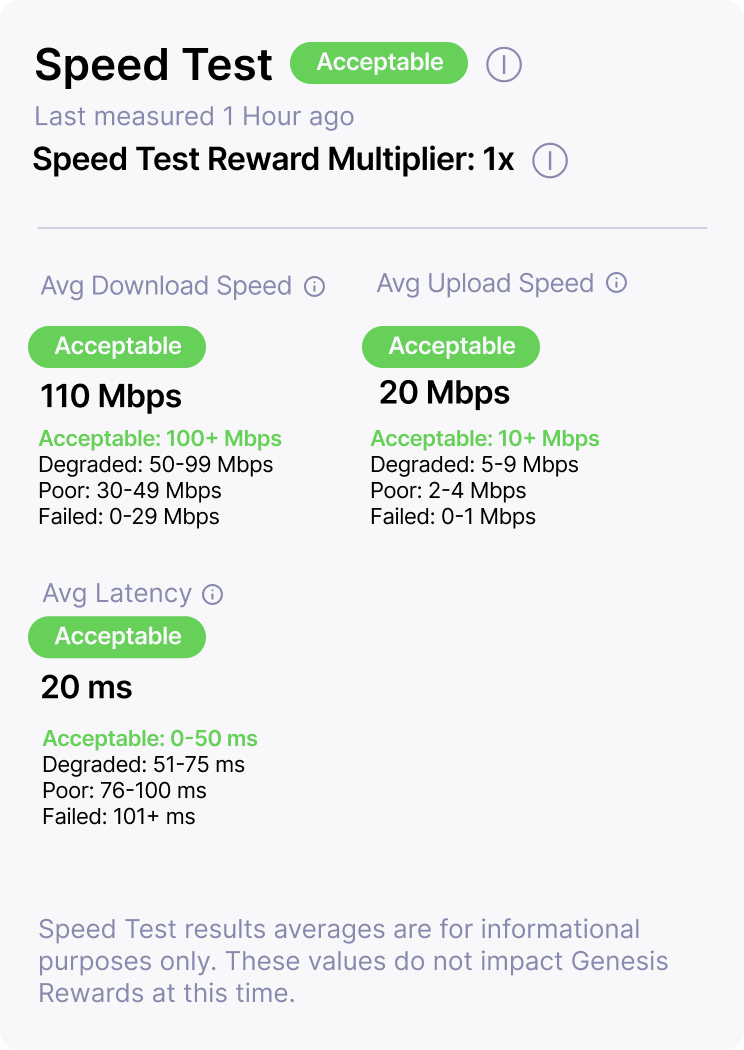
The Moving Average for all Speed Test metrics is in the Acceptable range.
A 1.0x multiplier is applied for the current Reward Period.
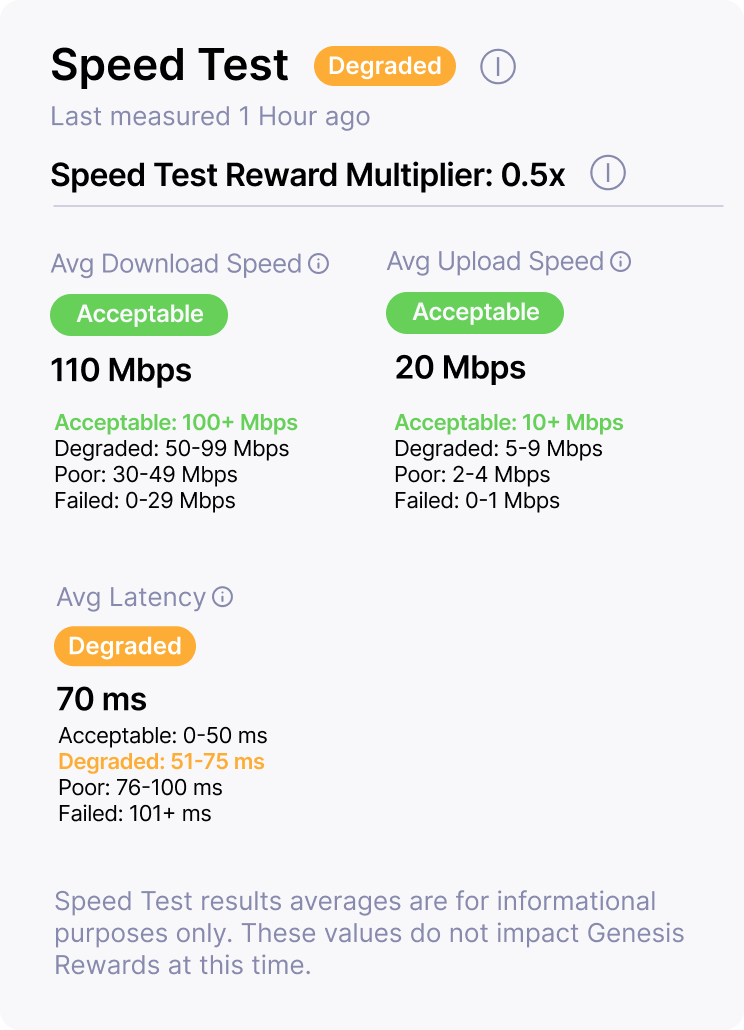
The Moving Average for Upload and Download metrics is in the Acceptable range,
however the 80 ms Latency metric is in the Degraded Tier.
A 0.5x multiplier is applied for the current Reward Period.
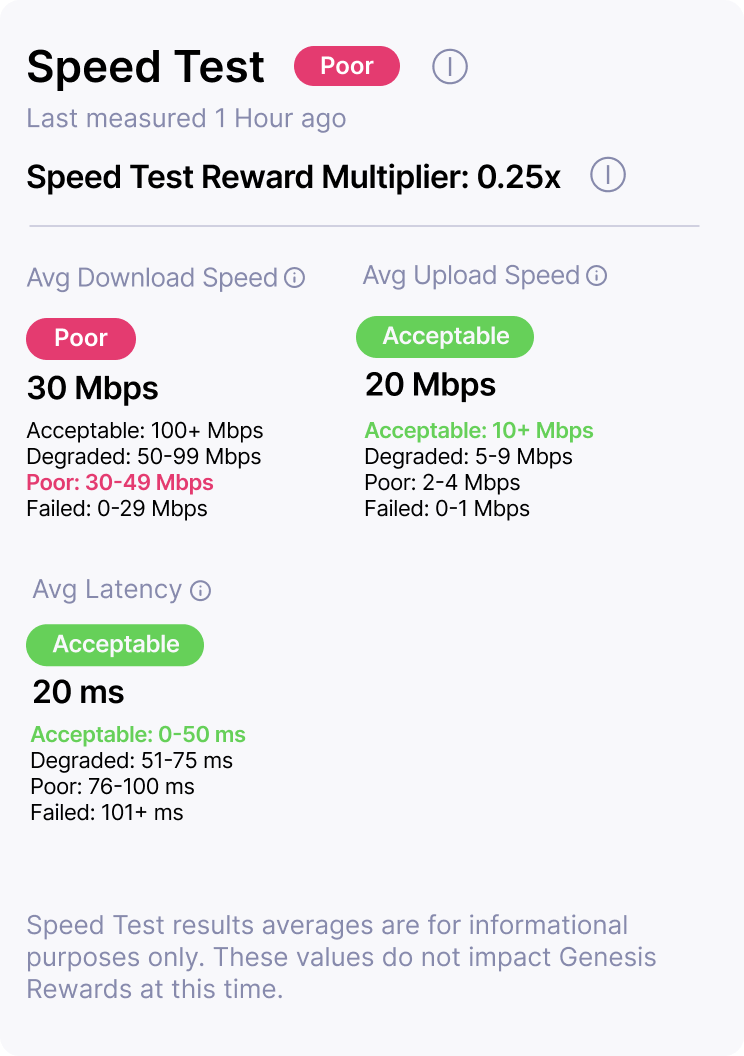
The Moving Average for Upload and Latency metrics is in the Acceptable range,
however the 30 Mbps Download metric is in the Poor Tier.
A 0.25x multiplier is applied for the current Reward Period.
- 🆘 Speed Test Fail
- ⏺️ Not Measured
- ⏺️ No Recent Data
- ⏺️ Not Enough Data
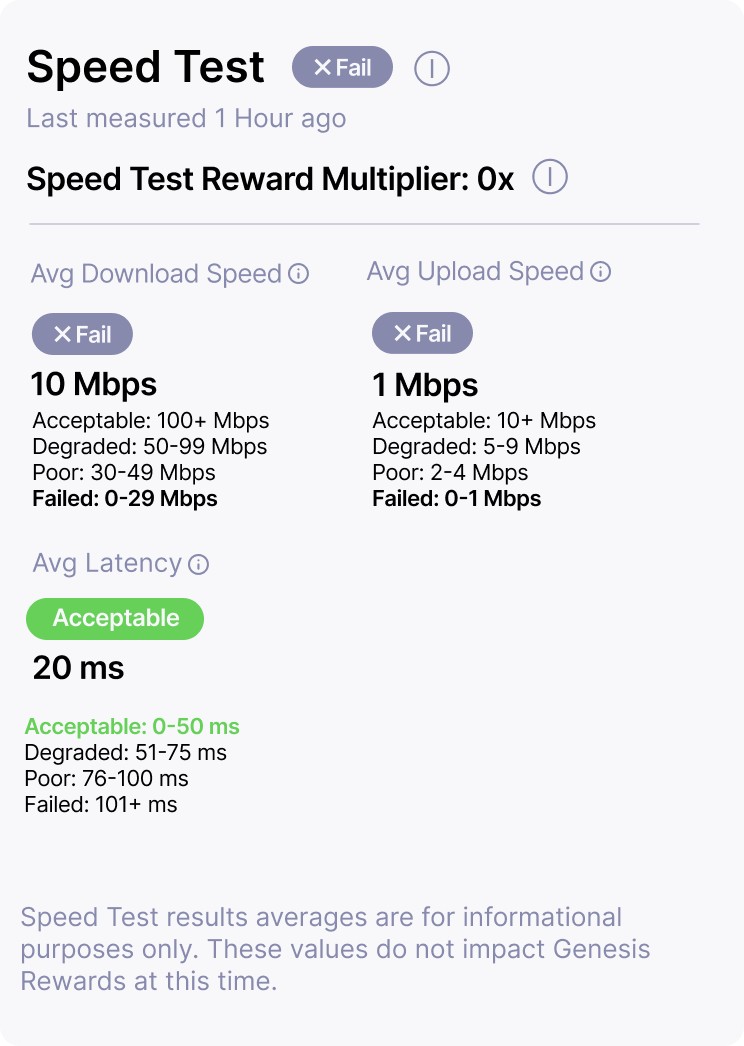
The Moving Average for Latency metrics is in the Acceptable range, however the
10 Mbps Download and 1 Mbps Upload metrics are below the Poor
Tier.
A 0.0x multiplier is applied for the current Reward Period.
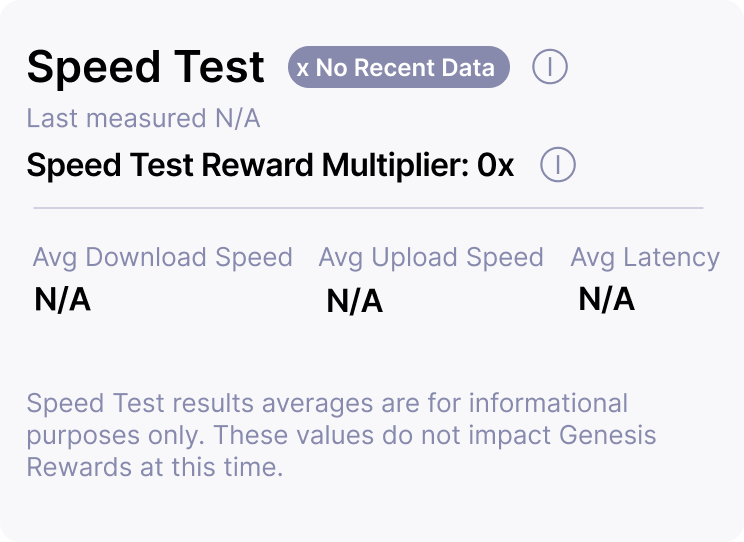
This status appears when a 5G Hotspot has been recently installed, and no Speed Tests have been performed.
A 0.0x multiplier is applied for the current Reward Period.
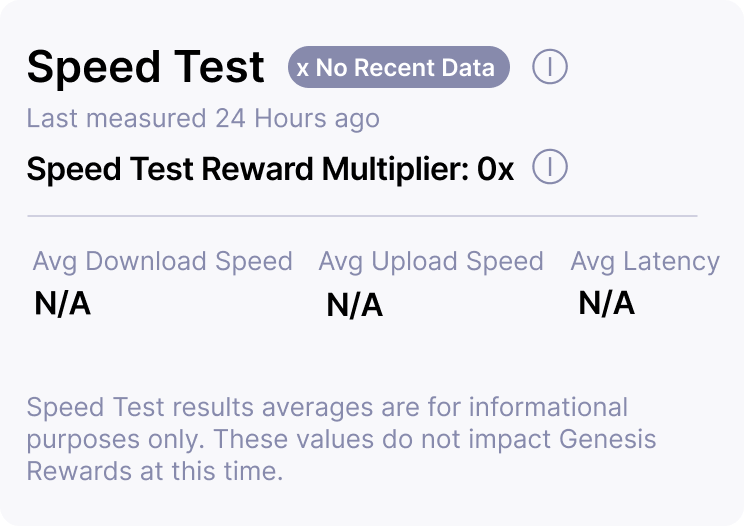
This status appears when a Speed Test could not be performed in the previous 24 hours. For example, when a 5G Hotspot has recently recovered from a prolonged network interruption, power interruption, or other connection interruptions have occurred.
A 0.0x multiplier is applied for the current Reward Period.
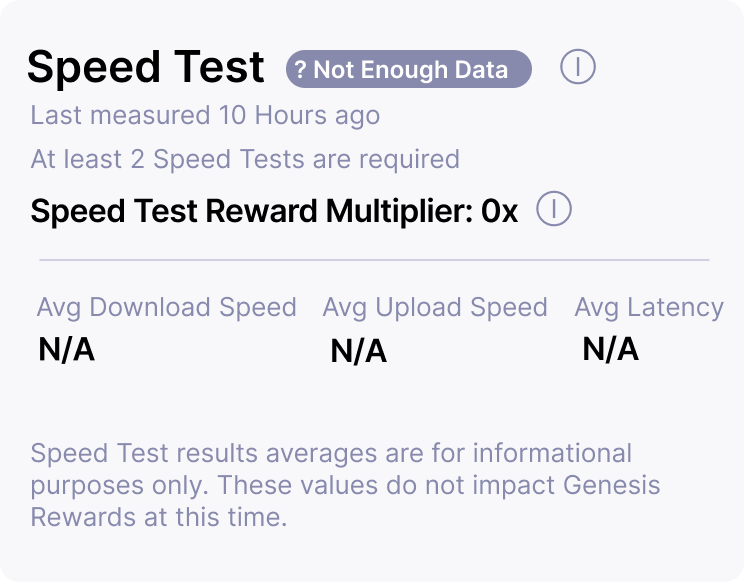
This status appears when there are fewer than 2 available Speed Test records,
and a Moving Average can not yet be calculated.
This is common when a 5G Hotspot has been newly installed, has recently recovered from a prolonged network interruption, or in other scenarios where a Speed Test could not be performed.
A 0.0x multiplier is applied for the current Reward Period.